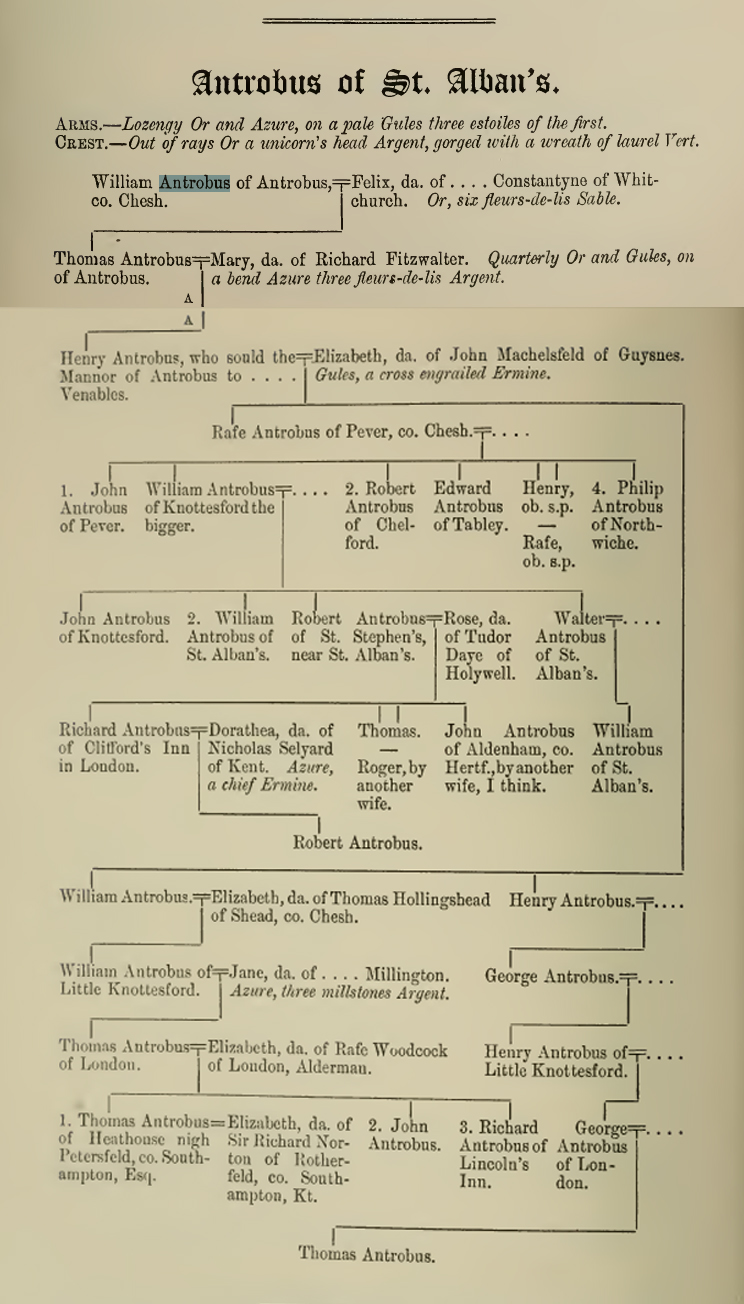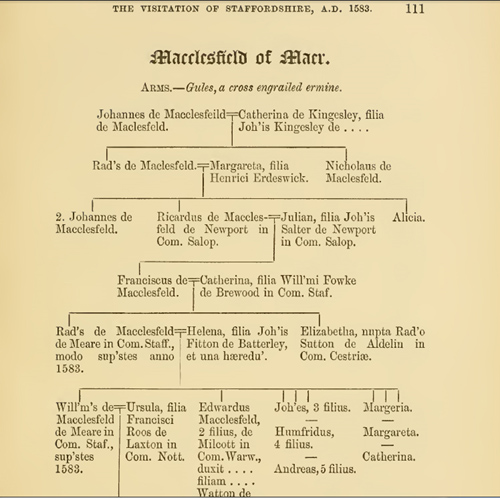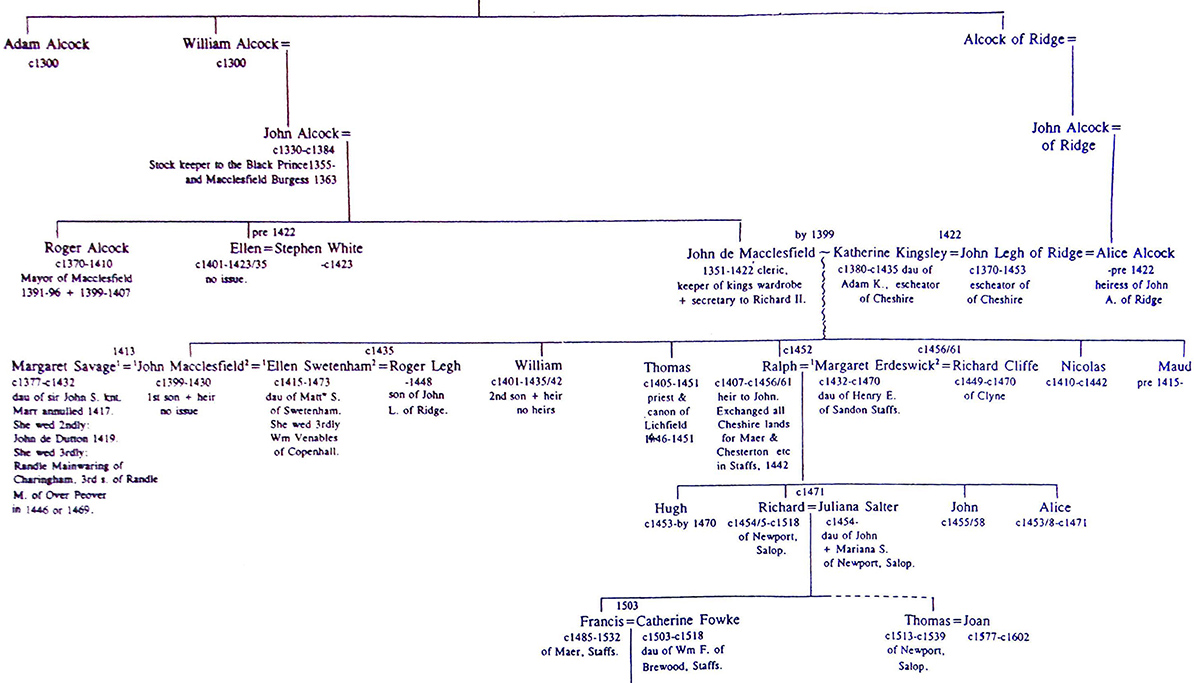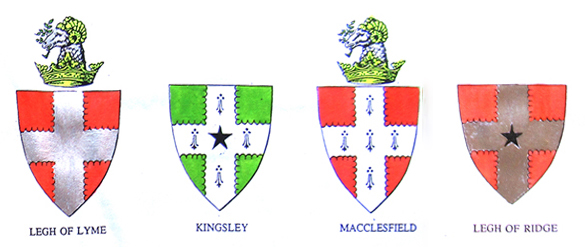| Home Page |
|---|



When I have looked into the history of and early known origins of the family name of Antrobus, and considered the main sources of information which are considered the best reference, then, probably, its going to be by looking at the lineages that were collected during the Herald’s Visitations, those records that are now held at the Herald’s College of arms. These formed the main sources for the earliest lineages drawn up in the 1929 publication by Sir Reginald Antrobus called Antrobus Pedigrees, probably still the most referenced source for the history of the Antrobus name. When he researched the early pedigrees and had amassed a lot of data, it was with the lineages collected by the herald’s visitations that he based the origins of all the Antrobus lineages he found and formulated. All the contemporary data he collected he was able to trace back to the early records held by the Herald’s College. From this research he concluded that everyone with an Antrobus lineage must be descended from lineages held by the Heralds College of Arms. There was little else known about the earliest generations with almost no records earlier than the sixteenth century. Unfortunately, there does not seem to be much contemporary information to prove the earlier lineages held be the Herald’s college. It is only when the later 16th century is reached that contemporary documents become available. Reginald Antrobus did find a number of documentary references where similar names are mentioned, which at least could be taken as supporting evidence. However, it should be noted that until recently, the lineages recorded by the Herald’s College of Arms were assumed to be a gold standard of authenticity. With that belief, earlier genealogists often took such lineages and tagged them onto later lineages without much critical analysis. It is only in more recent times that a more critical eye has been cast over these earlier genealogies held by the College of Arms. When Reginald used these earlier lineages in the 1920s, there seemed little need to prove them further. This being the case, the lineages in Reginald’s Pedigrees are all linked back to a single early lineage dating back to the fourteenth century.
It is generally accepted now that not all the lineages held by the Herald’s College of Arms are going to be accurate, many of these were simply accepted at face value when they were first entered, while others were probably taken with a bribe. There was such status to having a family coat of arms that people would resort to deceptions to have a coat of arms attributed to their family. Centuries ago, when the aristocracy held all the power in the land, the king considered it important enough to send out the Heralds to assess the claims by all the families in the land to determine which were genuine claims and which were false. Every family had to prove that a coat of arms was genuine with a lineage that showed where the family received its coat of arms. It’s perhaps not surprising, then, that the longer the linage, and the further back into the past that linage spanned, the less accurate and reliable it is likely to be. And indeed, when one looks at the earliest generations in the Antrobus lineage gathered by heralds we find the earliest three generations married into families with armorial bearings, that is a coat of arms. This suggests that these three generations of the Antrobus family must have had wealth and status high enough to marry into such a family. Thus, for the first three successive generations recorded, the wives listed in the lineage are accompanied by a description of her family arms. However, most of the later generations would seem to be of lowly farming backgrounds and all wedded to local spouses of similar backgrounds. Observing this seemingly rapid decline in the family fortunes one is presented an obvious question, are the three early generations genuine ancestors or were they tagged onto to the end of the list to add credibility and prove that the family are descended from noble stock; thus, allowing later generations to bear a coat of arms? These descriptions are shown below, taken from the Hertfordshire Visitations of 1634.
We see in the lineage shown below that it starts with William Antrobus of Antrobus, whom Reginald identifies as being the same as a William Antrobus living in 1360 who is mentioned in a court roll. This is followed by Thomas Antrobus, also of Antrobus, and after him is Henry Antrobus, who is noted as: “Who sold the Manor of Antrobus to Venables.” We see that William Antrobus married a daughter of Constantyne of Whitchurch (Probably in Whitchurch in Shropshire). And William’s son, Thomas, married a daughter of Richard Fitzwalter. Both these families have an Armorial description. As indeed does the next marriage of William’s grandson, Henry Antrobus. So, we have the impression our three earliest generations married well, into wealthy families. But are they genuine? They stand out because they indicate that the Antrobus family was one with some status to be able to marry into families that seem to be higher up in the social order. This first investigation will focus on the last name in the three earliest generations, Henry Antrobus, as his is the generation that links us to his higher status forebearers and his offspring, Most of whose descendants, (but by no means all), seem to have become yeomen farmers, traders and tenants, suggesting a much lower status as aristocracy considered tradesmen as beneath them. Yeomen and merchants, however, were always seeking to better themselves, and what better way to show this than be showing off a family crest. This is certainly the achievement of Thomas Antrobus of Lincoln’s Inn, great grandson of Henry Antrobus, who, after being elected to parliament in 1604, was granted a coat of arms and crest by William Camden, Clarenceux King of Arms. That he was granted arms, and was great grandson of the Henry Antrobus in question, does add some credibility that the lineage held by the College of arms is correct. See the lineage below:

In the early lineages collected by the Heralds Visitations, Henry Antrobus of Antrobus is shown as marrying Elizabeth Machelsfeld, daughter of John Machelsfeld de Guysnes. Machelsfeld is an early spelling of the name Macclesfield, a town in the north west of England. Although Elizabeth Machelsfeld appears to come from a place called Guysnes, her family, if the lineage held at the Herald’s College of arms is correct, have the armorial arms of the Macclesfield family: Gules, a cross engrailed Ermine. This suggests her lineage is from a prominent family and as such this should be a big clue to identifying her and her family. In other words the armorial bearings should be the proof of it. However, it seems that trying to identify Elizabeth Machelsfeld and her father, John de Machelsfeld of Guysnes, would not be as simple as one would expect. The Macclesfield family that actually bore the arms Gules, a cross engrailed Ermine were, in fact, the Macclesfield’s of Maer. The lineage descends from a John Alcock, who changed his name to John de Macclesfield in the fourteenth century. John Alcock de Macclesfield, though a priest, had five sons with his consort, Katherine de Kingsley, and they became one of the most prominent of families in Macclesfield town. It is this family, descending from John Alcock who would, over three generations, became the Macclesfield’s of Maer.


Fullest known lineage of Macclesfield of Maer to the 16th century
In the Macclesfield de Maer lineage, John de Macclesfield and his consort, Katherine Kingsley, have a son and a grandson called John Macclesfield. Their son, John Macclesfield jnr was born in 1399, and their grandson, John Macclesfield, son of Ralph Macclesfield, was born between 1455 and 1458. Unfortunately, the above lineage has a note telling us that John Macclesfield jnr, though married twice, had no issue. Also, John Macclesfield, son of Ralph, is shown with no indication of wife or issue. It is possible that in both cases a lack of information or connection has led to either one or the other not showing Elizabeth de Machelsfeld as a daughter. Her birth would be approximately twenty-five years to thirty years on average after the birth of her father. Therefore, we are looking at around 1424 – 29 in the case of John Macclesfield jnr, and 1475 to 81 for John Macclesfield, son of Ralph. Henry Antrobus is thought to have sold the manor at Antrobus in 1460 and we would presume that he was already an adult then.
However, if Elizabeth Machelsfeld was the daughter of John Macclesfield, son of Ralph, she would not have been born for another fifteen to twenty years after this date of sale, hence by the time she would be of marriable age, Henry Antrobus would probably have been quite elderly. That makes the grandson, John Macclesfield, son of Ralph, unlikely to have been the father of Elizabeth de Machelsfeld, leaving John Macclesfield Jr. Also, analysis of the Antrobus lineage taken from Reginald Antrobus’ pedigrees indicates that the likely year of birth for Henry Antrobus approximates to five to ten years either side of the year 1440. This would make Henry Antrobus and Elizabeth Machelsfeld approximately of the same age range if she were the daughter of John Macclesfield jnr. However, despite the encouraging birth date analysis, a serious problem in trying to link Elizabeth Machelsfeld to the Macclesfield of Maer lineage remains. This is because there is the obvious fact that the father of Elizabeth is called John Machelsfeld of Guysnes. There is no indication that John Macclesfield Jnr of the Maer lineage having any connection with Guysnes. The Macclesfield’s of Maer seem to all have been connected with the catholic clergy at this time, despite marrying and having offspring. There is no indication that they left England. Therefore, if Elizabeth’s family were the Machelsfeld’s of Guysnes, can they really be connected with the Macclesfield’s of Maer?
The lineage of the Macclesfield’s of Maer, shown above, therefore does not provide an obvious connection to Elizabeth Machelsfeld. And yet the Hertfordshire visitations of 1634 have the same arms of the Macclesfield’s of Maer described with the Machelsfeld’s of Guysnes, making the link seem firm. Perhaps one clue is the spelling of the name. In the records kept by the herald’s college there is an obvious difference, the Macclesfield’s of Maer tends to use the same spelling as used for the town, at least since the visitations started in the sixteenth century. This could indicate that the two are from different origins, but for one reason or another, due to the similarity of the spelling, it seems to have become generally accepted they must be of the same family. The lineage of the Antrobus family was probably recorded in 1604 – being produced for Thomas Antrobus of Lincolns Inn when he was granted a coat of arms in recognition of his becoming a member of Parliament for Andover. Other than the records held in the Harleian records there do not appear to be any other contemporary records of Henry Antrobus or his wife Elizabeth Machelsfeld that provide further references to a family called Machelsfeld of Guysnes.
The use of the Macclesfield name has always been varied and confused. Very early histories do show that there have been a multitude of spellings used for Macclesfield, including the name Maxfeld, before the fifteenth century. The early nineteenth century historians of Cheshire, including Ormerod, all had trouble organising the histories around the Macclesfield’s, the De Legh’s, the De Kingsley’s and the Savage families. The Kingsley’s and the De Legh’s of Adlington, Lyme and Ridge were very closely connected with the Macclesfield’s of Maer, and the Savage’s of Ridge were another branch of the De Legh family. Several of the De Legh family who resided in Macclesfield adopted the name De Macclesfield as well as being connected with the Macclesfield through marriage. Thus separating the families out has led to many erroneous claims over the years. This was further confounded by the fact that all these families had armorial bearings that were almost identical.

The Armorial shields of the Legh, Kingsley and Macclesfield’s, John de Macclesfield based the Macclesfield arms on those of his 'wife’s' family, the Kingsley arms
The discovery that the Macclesfield’s of Maer were, in earlier generations, called Alcock and not actually descended from the De Legh’s is a fairly recent development. It seems that the marriage of John Macclesfield Jnr to Margaret Savage of Ridge was arranged when they were children, but when they came of age the marriage between them was Annulled in 1417. He later married Ellen Swettenham and they apparently had no issue (maybe due to his being in the holy orders). John Macclesfield Jnr died in 1430 and Ellen was later remarried in 1435 to Roger de Legh. Despite the confusion in the records, Ormerod agrees that John Macclesfield Jnr did not have any issue, and later historians tend to agree.
None of these details, of course, help in establishing any connection between this John Macclesfield Jnr and John Machelsfeld de Guysnes. Indeed, it seems very unlikely that they would be the same person. To connect the two, a reference to the place name Guysnes for both seems to be the most obvious connection to find, but there is no mention of John Macclesfield Jnr, or indeed any of the Macclesfield’s of Maer, being connected to a place called Guysnes. There are two places of old that the name Guysnes could apply to, historically the spelling of Guysnes could be applied to the better-known place in France, now spelt Guînes, but there was also a time when Guyzance in Northumberland was spelt Guizance and it could be a reference to this name. Also, what of the other known John de Macclesfield’s descended from the Legh families who adopted the Macclesfield name. These families are closely connected, John Legh of Ridge married Katherine Kingsley after the death of John Macclesfield Snr of the Maer branch, after which John Legh of Ridge took the name Macclesfield. The shields above show two of the Legh branches, Legh of Ridge and Legh of Lyme. These two branches stem from younger brothers of the Adlington Legh’s. The Macclesfield arms seem to have been issued around 1593 and it seems, according to a history written by Tony Dunn written in 1995, at the time of issue it was erroneously thought that the Macclesfield’s of Maer descended from the Legh’s of Lyme. The error probably has its origin in a Staffordshire history written by the Elizabethan author Sampson Erdeswick, a relation of the Macclesfield’s of Maer, in 1593. He would have been aware of the marriage of his ancestor, Katherine Kingsley, to John Legh of Ridge, and when the arms were issued at that same time, they were based closely on the Legh arms. Only many centuries later was it understood that the Legh connection was that of step-father and not direct descent.
So where does this leave us with the search for the origins of Elizabeth de Machelsfeld? How did she have the crest of Macclesfield of Maer attached to her name, yet have no obvious line of decent or connection with that lineage. Let us consider that her father is called John de Machelsfeld of Guysnes, this indicating a different line of descent, as do the other factors already considered. To recap; She does not appear in their lineage tree, the John Macclesfield who, in the Maer lineage, was living at the right time to be her father actually had no issue. And neither did the John Macclesfield in the next generation, John Macclesfield, son of Ralph – he appears without wife or children Also, there appears to be no connection between the Macclesfield’s of Maer and Guysnes. So where does this leave us. The next place to look is at the Harleian records themselves; this was where the connection seems to have been made. What do the records at the Herald’s college of Arms say about the Macclesfield crest?